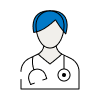Lung cancer is the uncontrolled growth of cells in the lungs. This creates a lump (tumour) that can be either malignant (cancerous) or benign (not cancerous).
Lung cancer can start in the lining of your bronchi or your lung tissue – this is known as primary lung cancer. Cancer that has spread to the lungs through your bloodstream or your immune system from another part of your body is known as secondary lung cancer.
Types of lung cancer
There are two main types of lung cancer: non-small-cell (NSCLC) and small-cell (SCLC).
Non-small-cell lung cancerAbout eight in 10 primary lung cancers are diagnosed as NSCLC. There are three types of NSCLC.
- Squamous cell carcinoma is the most common type of lung cancer and affects the bronchi.
- Adenocarcinoma mainly affects the outer part of your lungs and is the most common lung cancer in women and non-smokers.
- Large cell carcinoma can affect any part of the lungs and occurs in about one in 10 of all lung cancers.
It's not always possible to identify the exact type of NSCLC you have and you may be diagnosed with 'undifferentiated' NSCLC. This won't make any difference to your treatment as all NSCLC is treated the same way (see Treatment of lung cancer).
Small-cell lung cancerThis type of lung cancer starts in the smallest cells in your lungs – usually in the cells lining your bronchi. It can develop very fast and spread to other parts of the body very early – often before it's been diagnosed. For this reason SCLC can be difficult to treat.
Causes of lung cancer
Smoking is the major cause of lung cancer, causing around nine in 10 lung cancers. Passive or second-hand smoking (breathing in other people's smoke) is also linked to lung cancer.
Other factors that make lung cancer more likely include the following.
- Exposure to asbestos.
- Exposure to high levels of radon gas, a naturally occurring radioactive gas.
- Not enough fruit and vegetables in your diet.
- Previous lung disease.
- A weakened immune system, for example if you have HIV/AIDS.
Symptoms of lung cancer
Most people with lung cancer have no early symptoms at all, but others may have:
- a cough – this can come on gradually
- a change in a cough you have had a long time – for example if you smoke, a constant dry cough may become chesty
- blood-stained phlegm (sputum)
- shortness of breath
- loss of appetite
- weight loss
- tiredness
Less common symptoms include:
- swelling of your face or neck
- a hoarse voice
- chest or shoulder pain
- broadening or thickening of the tips of the fingers (called clubbing)
These symptoms aren't always caused by lung cancer but if you have had them for longer than three weeks, see your doctor.
Diagnosis of lung cancer
Your doctor will ask you about your symptoms and examine you. He or she may also ask you about your medical history. Your doctor will usually refer you for a chest X-ray.
If your chest X-ray shows signs of lung cancer, you will usually be referred to a doctor who specialises in chest disease.
You may have the following tests to confirm diagnosis, find out the type of cancer you have and if the cancer has spread (this is called cancer staging).
- CT scan. This uses X-rays to make three-dimensional images of part of the body.
- Bronchoscopy. This is a procedure used to look inside your lungs. A narrow, tube-like, telescopic camera is passed down your windpipe into your lungs. Your doctor may remove a sample of tissue (a biopsy). This will be sent to a laboratory for testing to determine the type of lung cancer.
Treatment of lung cancer
Treatment of lung cancer depends on the type of cancer, how far it has spread and your general health.
SCLC is usually treated with chemotherapy because it has often spread by the time it's diagnosed. NSCLC may be treated with surgery, chemotherapy, radiotherapy, laser treatment, or a combination of these methods. Your doctor will discuss your treatment options with you.
Non-surgical treatments- Radiotherapy uses radiation to destroy cancer cells. A beam of radiation is targeted on the cancerous cells, which shrinks the tumour.
- Radiotherapy is commonly given with chemotherapy, particularly in SCLC.
- Chemotherapy uses medicines to destroy cancer cells. It's the main treatment in SCLC but can also be used in NSCLC. You may have it before or after surgery or with radiotherapy.
- Biological therapies are medicines that use substances occurring naturally in your body to kill cancer. The substances are manufactured so that they can be used in larger quantities to fight cancer. These include erlotinib (Tarceva), gefitinib (Iressa), cetuximab (Erbitux), and bevacizumab (Avastin).
- Radiofrequency ablation (or laser therapy) is when a high-energy beam of light is used to destroy cancer cells. It's suitable if you have early stage NSCLC or you don't want or can't have surgery.
- Photodynamic therapy is when light-sensitive medicines are injected into your body and absorbed by the cancer cells. A low-powered laser is used to activate the medicines. This treatment is suitable if you have small early stage NSCLC, or when you don't want or can't have surgery.
SurgerySurgery may be used to treat NSCLC if the cancer hasn't spread. A small section, a lobe or a whole lung may be removed, depending on the size, type and position of the cancer. It also depends on how healthy your lungs are to start with.
Advanced lung cancerLung cancer can be difficult to cure because often it doesn't cause symptoms until it has already spread. Where a cure isn't possible, your treatment will aim to give you as good a quality of life as possible. This is known as palliative care.
You may be offered a combination of the treatments described here to help shrink the tumour and control your symptoms. Medicines are also available to help relieve other symptoms such as pain, cough, feeling sick and vomiting and poor appetite.
Prevention of lung cancer
You can reduce your risk of developing lung cancer by making certain lifestyle changes such as:
- stopping smoking
- not drinking excessive amounts of alcohol
- eating a balanced diet with at least five portions of fruit and vegetables a day
Disclaimer
This information was published by Bupa Group's Health Content Team and has been reviewed by appropriate medical or clinical professionals. To the best of their knowledge the information is current and based on reputable sources of medical evidence, however Bupa (Asia) Limited makes no representation or warranty as to the completeness or accuracy of the Content.
The information on this page, and any information on third party websites referred to on this page, is provided as a guide only. It should not be relied upon as a substitute for professional medical advice, nor is it intended to be used for medical diagnosis or treatment. Bupa (Asia) Limited is not liable for any loss or damage you suffer arising out of the use of, or reliance on, the information.
Third party websites are not owned or controlled by Bupa and any individual may be able to access and post messages on them. Bupa is not responsible for the content or availability of these third party websites. Last updated August 2017.










